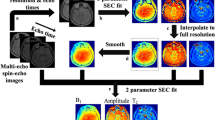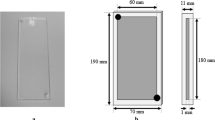Abstract
Object
Eddy current compensation by dynamic reference phase modulation (eDREAM) is a compensation method for eddy current fields induced by B 0 field-cycling which occur in delta relaxation enhanced MR (dreMR) imaging. The presented method is based on a dynamic frequency adjustment and prevents eddy current related artifacts. It is easy to implement and can be completely realized in software for any imaging sequence.
Materials and methods
In this paper, the theory of eDREAM is derived and two applications are demonstrated. The theory describes how to model the behavior of the eddy currents and how to implement the compensation. Phantom and in vivo measurements are carried out and demonstrate the benefits of eDREAM.
Results
A comparison of images acquired with and without eDREAM shows a significant improvement in dreMR image quality. Images without eDREAM suffer from severe artifacts and do not allow proper interpretation while images with eDREAM are artifact free. In vivo experiments demonstrate that dreMR imaging without eDREAM is not feasible as artifacts completely change the image contrast.
Conclusion
eDREAM is a flexible eddy current compensation for dreMR. It is capable of completely removing the influence of eddy currents such that the dreMR images do not suffer from artifacts.







Similar content being viewed by others
References
Alford JK, Rutt BK, Scholl TJ, Handler WB, Chronik BA (2009) Delta relaxation enhanced MR: improving activation-specificity of molecular probes through R1 dispersion imaging. Magn Reson Med 61(4):796–802
Alford JK, Farrar CT, Yang Y, Handler WB, Chronik BA, Scholl TJ, Madan G, Caravan P (2011a) Direct albumin imaging in mouse tumour model. In: Proceedings of the 19th scientific meeting, international society for magnetic resonance in medicine, Montreal, p 318
Alford JK, Sorensen AG, Benner T, Chronik BA, Handler WB, Scholl TJ, Madan G, Caravan P (2011b) Direct protein imaging of inflammation in the human hand. In: Proceedings of the 19th scientific meeting, international society for magnetic resonance in medicine, Montreal, p 452
Hoelscher UC, Lother S, Fidler F, Jakob P (2011) Reference free localization and quantification of contrast agents using relaxivity dispersion at 1.5t. In: Proceedings of the 19th scientific meeting, international society for magnetic resonance in medicine, Montreal, p 2734
Hoelscher UC, Lother S, Fidler F, Blaimer M, Jakob P (2012) Quantification and localization of contrast agents using delta relaxation enhanced magnetic resonance at 1.5 T. Magn Reson Mater Phy 25(3):223–231
Gach HM, Lowe IJ, Madio DP, Caprihan A, Altobelli SA, Kuethe DO, Fukushima E (1998) A programmable pre-emphasis system. Magn Reson Med 40(3):427–431
Fry ME, Pittard S, Summers IR, Vennart W, Goldie FTD (1997) A programmable eddy-current compensation system for MRI and localized spectroscopy. Magn Reson Imaging 7(2):455–458
Bartusek K, Kubasek R, Fiala P (2010) Determination of pre-emphasis constants for eddy current reduction. Meas Sci Technol 21(10):105601–105610
Crozier S, Eccles CD, Beckey FA, Field J, Doddrell DM (1992) Correction of eddy-current-induced b0 shifts by receiver reference-phase modulation. J Magn Reson 97(3):661–665
Crozier S, Beckey F, Eccles C, Field J, Doddrell D (1994) Correction for the effect of induced b0 shifts in localized spectroscopy and imaging by direct frequency modulation. J Magn Reson Ser B 103(2):115–119
Harris CT, Alford JK, Handler WB, Scholl TJ, Chronik BA (2010) Bo coil designs for in vivo delta relaxation enhanced MR in humans. In: Proceedings of the 18th scientific meeting, international society for magnetic resonance in medicine, Stockholm, p 1548
Bartusek K, Puczok V (1993) An NMR multifid method for measurement of magnetic field gradient. Meas Sci Technol 4(3):357–361
Goodyear DJ, Shea M, Beyea SD, Shah NJ, Balcom BJ (2003) Single point measurements of magnetic field gradient waveform. J Magn Reson 163(1):1–7
Meyer M (2009) Signalverarbeitung: analoge und digitale Signale, Systeme und Filter, 5th edn. Vieweg und Teubner, Wiesbaden
Bottomley PA, Foster TH, Argersinger RE, Pfeifer LM (1984) A review of normal tissue hydrogen NMR relaxation times and relaxation mechanisms from 1–100 MHz: dependence on tissue type, NMR frequency, temperature, species, excision, and age. Med Phys 11(4):425–448
Diakova G, Korb JP and Bryant RG (2012) The magnetic field dependence of water T1 in tissues. Magn Reson Med 68(1):272–277
Hoelscher UC, Gruenewald A, Blaimer M, Jakob P (2012) Relaxation dispersion contrast of tissue at 1.5T. In: Proceedings of the 19th scientific meeting, international society for magnetic resonance in medicine, Melbourne, p 2354
Haacke EM, Brown RW, Thompson MR, Venkatesan R (1999) Magnetic resonance imaging: physical principles and sequence design. Wiley, New York
Acknowledgments
This work was performed with support from the Federal Ministry of Education and Research under Award No 01EZ0816, Siemens Healthcare Sector Erlangen and the Bavarian Ministry of Economic Affairs, Infrastructure, Transport and Technology. We thank Philipp Kagerbauer, Sabine Voll and Stephanie Weibel for their support with the in vivo measurements.
Author information
Authors and Affiliations
Corresponding author
Rights and permissions
About this article
Cite this article
Hoelscher, U.C., Jakob, P.M. Eddy current compensation for delta relaxation enhanced MR by dynamic reference phase modulation. Magn Reson Mater Phy 26, 249–259 (2013). https://doi.org/10.1007/s10334-012-0335-6
Received:
Revised:
Accepted:
Published:
Issue Date:
DOI: https://doi.org/10.1007/s10334-012-0335-6




